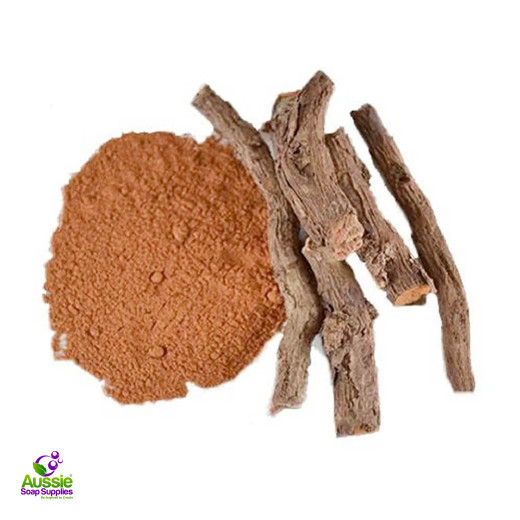New Stock February 2023: is Rubia Cordifolia.
Rubia cordifolia is also known as Indian madder or manjit (majith, manjistha etc.) and produces a coral-terracotta-pink botanical dye for use in soap and fabrics. The strength of colour can vary from palest peach to a rosy pink to a deep earthy terracotta brown, depending on the amount used and method. The powdered root is the easiest to use in soap as it gives you consistent results.
We have trialed our Cordifolia stock to find the easiest way to use it in soap. Used directly into the traced soap only produced a fairly light terracotta coloured bar, or a very strong robust terracotta colour. It gives a slightly different result than our previous Tinctoria stock. You can see our blog HERE and recipe HERE.
Rubia Cordifolia usage:
Soaping Notes: We infused the powder in the olive oil portion of our soap batch. To achieve the darkest colour, a good hot gel makes all the difference.
CAS #: 91845-24-8
Appearance: Orange/red, fine powder
For those still using our previous stock (purchased before February 2023):
Rubia Tinctoria usage: If using directly into traced soap, we suggest starting with 2 rounded teaspoons per 2kg of oil weight. Either moisten with some Olive Oil, or add directly to the traced soap. This will give you soap as the paler coloured soap with the pattern shows (½ teaspoon of Madder Root Powder in oil, added to 250g of traced Cold Process soap). If you wish to avoid the specks and go for the darker look, double or triple infuse into oil first, and then use as a part of the oil portion.
Historically:
There are many species of Madder which has been used throughout history originating in many parts of the world. This root has been used for as a dye for at least 3000 years. The earliest example of madder dyed linen was found in Tutankhamen's Tomb (from 1350 BC), and it is considered to have been used in prehistory. Popular with the Vikings, and during the Middle Ages, it was in the 19th Century madder was finally made into a longer lasting pigment which we know as "Madder Lake" (the dyestuff is known as Alizarin)
Dioscorides and Pliny the Elder (De Re Natura) mention the plant (Rubia passiva). In Viking age levels of York, remains of both woad and madder have been excavated. The oldest textiles dyed with madder come from the grave of the Merovingian queen Arnegundis in St. Denis near Paris (between 565 und 570 AD). In the "Capitulare de villis" of Charlemagne, madder is mentioned as "warentiam". The herbal of Hildegard of Bingen mentions the plant as well. The red coats of the British Redcoats were dyed with madder. According to Culpepper's herbal, the plant is ruled by Mars and has an opening quality, and will bind and strengthen afterwards........ interesting huh?
| INCI: | Rubia cordifolia |









